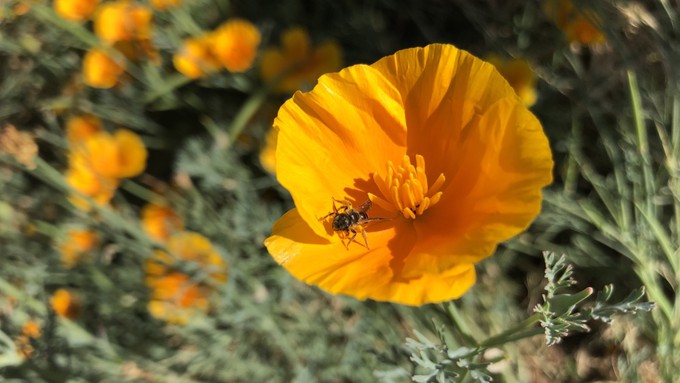
Test your knowledge with a quiz

The California poppy of course is the state flower. It's an important plant for pollinators, including this ligated furrow bee, a type of sweat bee. Kathy Morrison
Through Saturday, it’s California Native Plant Week, and I can’t think of a better time to plant two or 12 or 222 California natives.
These are the plants that grew here before suburbs and urbs, before gardeners from other areas began importing their favorites from other parts of the country or the world. Our native plants are uniquely adapted to our climate and to our native pollinators (including birds).
In the spirit of celebration, I put together a quick (and fun, I hope) quiz on California natives. See how much you already know about them:
1. Which was the first native plant to receive an “official” state designation?
a) California redwood, state tree
b) Purple needle grass, state grass
c) California poppy, state flower
2. The California poppy (Eschscholzia californica), by the way, beat out which other native(s) to win the title of state flower? Choose any that apply:
a) Windpoppy (Papaver heterophyllum)
b) Coulter's matilija poppy (Romneya coulteri)
c) Mariposa lily (Calochortus sp.)
d) Red ribbons (Clarkia concinna)
e) California sunflower (Helianthis californicus)
3. Which of these natives is NOT a ceanothus?
a) Buck brush
b) Coyote bush
c) Deerbrush
d) Oregon tea tree
4. Which native plant has been endangered by poachers in the wild?
a) Bluff lettuce (Dudleya farinosa)
b) Black sage (Salvia mellifera)
c) Desert agave (Agave deserti)
d) Western redbud (Cercis occidentalis)
5. Oak trees (Quercus sp.) are considered a keystone species for California wildlife – important especially for native birds. Which of these oaks is not a native?
a) Blue oak (Q. douglasii)
b) Garry’s oak (Q. garryana)
c) Engelmann oak (Q. engelmannii)
d) Pin oak (Q. palustris)
e) Black oak (Q. kelloggii)
6. California has how many types of native plants, according to the California Native Plant Society?
a) 1,000
b) 2,500
c) 5,000
d) 6,000
Bonus: How can gardeners celebrate California Native Plant Week?
a) Join CNPS or a local chapter (Sacramento Valley for our region)
b) Sign up for the free Gardens Gone Native tour, to be held April 29 in Sacramento and Yolo counties. The self-guided tour will include about two dozen gardens planted primarily with natives.
c) Plant California natives! See the list of suggested plants and participating nurseries at Bloom! California.
d) Visit the UC Davis Arboretum and Public Garden to see its many native plantings. Or shop at the next Arboretum Nursery plant sale, which always includes a variety of natives.
Answers:
1. c) The California poppy became the official state flower in 1903. The redwood was designated in 1937 and the needle grass in 2004.
2. b) and c) They finished far behind in the legislative vote total.
3. b) Coyote bush. Its Latin name is Baccharis pilularis.
4. a) Dudleya farinosa and many other coast Dudleyas are in such danger from succulent poachers that in 2021 Gov. Newsom signed a bill specifically making Dudleya poaching illegal.
5. d) The pin oak is a popular landscape tree in California but it’s an import from the eastern and central United States.
6. d) It’s at least 6,000 and probably higher -- more than any other state. And roughly 40 percent of California’s native plants are found only within its borders.
Bonus: All of the above, of course!
Comments
0 comments have been posted.Sacramento Digs Gardening to your inbox.
Sites We Like
Garden Checklist for week of July 21
Your garden needs you!
* Keep your vegetable garden watered, mulched and weeded. Water before 8 a.m. to reduce the chance of fungal infection and to conserve moisture.
* Feed vegetable plants bone meal, rock phosphate or other fertilizers high in phosphate to stimulate more blooms and fruiting. (But wait until daily high temperatures drop out of the 100s.)
* Don’t let tomatoes wilt or dry out completely. Give tomatoes a deep watering two to three times a week.
* Harvest vegetables promptly to encourage plants to produce more. Squash especially tends to grow rapidly in hot weather. Keep an eye on zucchini.
* Pinch back chrysanthemums for bushy plants and more flowers in September.
* Remove spent flowers from roses, daylilies and other bloomers as they finish flowering.
* Pinch off blooms from basil so the plant will grow more leaves.
* Cut back lavender after flowering to promote a second bloom.
* It's not too late to add a splash of color. Plant petunias, snapdragons, zinnias and marigolds.
* From seed, plant corn, pumpkins, radishes, winter squash and sunflowers.